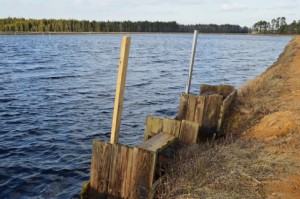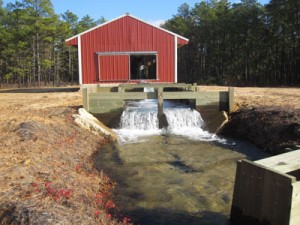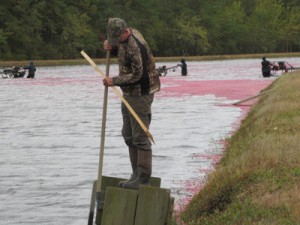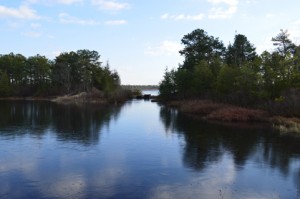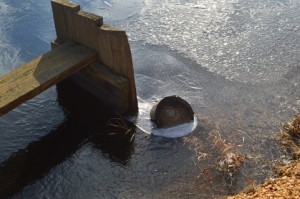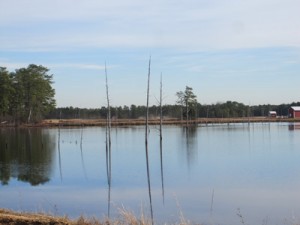Pine Island has just about finished another important part of our winter routine: the winter flood. Under normal conditions, the temperature steadily drops post-harvest; it is important to wait until the vines go dormant before starting to flood.
In last year’s winter flood entry, we talked about the importance of water level in the reservoirs. If there has no been significant rain to get the reservoirs to flooding level, we have to start our wells, continuing to use them to maintain the reservoirs and the stream needed to get the bogs completely flooded. Team member Matt Giberson, in his second season working with flood management, expressed some relief that this wasn’t necessary. “In some places we worried about not having enough water to flood everything, because reservoirs were so low,” he says. “There was one good storm at Sim Place that helped us harvest. We got about two or three inches to fill the reservoirs, and then it didn’t really rain until we started flooding. In addition to everything else, if we don’t have to run the wells it saves fuel.”
One of the late Bill Sr.’s favorite maxims about just about everything involving cranberries was, “Where is the water coming from, and where do you want it to go?” That can be one of the most challenging things to pick up when you are learning about Pine Island’s system. “I know the water much better this year, especially in the areas where my team was harvesting,” Matt says. “Better than last year, when I was still trying to learn everything. Harvest helped me learn a lot more about the water and how it works. There’s still a lot to learn, but it’s not something where you can pick up everything in a matter of days. It takes hands-on experience.”
The weather’s been a new experience for Matt, as well. “Ice on the gates and all the snow has made it tough to put the boards in. And then, of course, the water is ice cold!” But, he adds, “There’ve been no problems with the ice plugging the gates. That gets to be a real mess, but thankfully we’ve avoided it so far.” While it was very very cold last week, the wind didn’t affect us as much as it might have. “Fred [Torres, Pine Island GM] pointed out one of the problems with the wind, though: if it’s blowing hard enough that you can see the vines, you think you need to get out there and tweak things. You can’t do that; wait until it’s calm and then you’ll see what you really need to do.”
“We also put stems in every bog at Red Road so we can flood as we sand,” says Matt. Stems in the floodgates help get bogs to different water levels. “This means we can flood one and keep other low, then push water into next bog for sanding.” Once the winter flood is done, our team maintains reservoirs throughout the whole winter. “Ox Pasture, for example, has to stay high so we don’t have to run the well.” This is important because Ox Pasture, situated at the northernmost end of the property, is Pine Island’s largest reservoir and the primary source of water for the main farm.
Putting on the winter flood as quickly and efficiently as possible saves time, fuel, and most importantly, protects next year’s crop. It is this attention to the environment and continuous improvement of our processes that help us grow more acres and more fruit per acre with every successive year.

